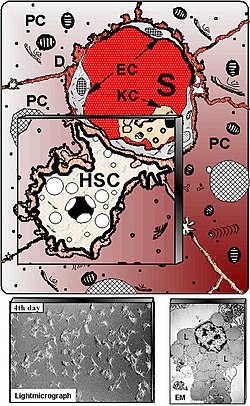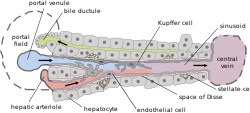Hepatic stellate cell
| Hepatic stellate cell | |
|---|---|
 Schematic presentation of hepatic stellate cells (HSC) located in the vicinity of adjacent hepatocytes (PC) beneath the sinusoidal endothelial cells (EC). S – liver sinusoids; KC – Kupffer cells. Down left shows cultured HSC at light-microscopy, whereas at down right electron microscopy (EM) illustrates numerous fat vacuoles (L) in a HSC, in which retinoids are stored. | |
 Basic liver structure | |
| Details | |
| Location | Perisinusoidal space of liver |
| Identifiers | |
| Latin | cellula perisinusoidalis; cellula accumulans adipem |
| MeSH | D055166 |
| TH | H3.04.05.0.00013 |
| Anatomical terms of microanatomy | |
Hepatic stellate cells (HSC), also known as perisinusoidal cells or Ito cells (earlier lipocytes or fat-storing cells), are pericytes found in the perisinusoidal space of the liver, also known as the space of Disse (a small area between the sinusoids and hepatocytes). The stellate cell is the major cell type involved in liver fibrosis, which is the formation of scar tissue in response to liver damage; in addition these cells store and concentrate vitamin A.
Structure
[edit]Hepatic stellate cells can be selectively stained with gold chloride, but their distinguishing feature in routine histological preparations is the presence of multiple lipid droplets in their cytoplasm.[1] Cytoglobin expression has been shown to be a specific marker with which hepatic stellate cells can be distinguished from portal myofibroblasts in the damaged human liver.[2] In murine (rats, mice) liver, reelin expressed by Ito cells has been shown to be a reliable marker in discerning them from other myofibroblasts.[3] The expression of reelin is increased after liver injury.
Function
[edit]In normal liver, stellate cells are described as being in a quiescent state. Quiescent stellate cells represent 5-8% of the total number of liver cells.[4] Each cell has several long cytoplasmic protrusions that extend from the cell body and wrap around the sinusoids.[5] The lipid droplets in the cell body store vitamin A as retinyl palmitate.[6] Hepatic stellate cells store 50–80% of the body's vitamin A.[6]
The function and role of quiescent hepatic stellate cells is unclear. Recent evidence suggests a role as a liver-resident antigen-presenting cell, presenting lipid antigens to and stimulating proliferation of NKT cells.[7]
When the liver is damaged, stellate cells can change into an activated state. The activated stellate cell is characterized by proliferation, contractility, and chemotaxis. This change is seen as a transdifferentiation whereby the cells lose their stellate shape and acquire that of myofibroblasts.[8][6] This state of the stellate cell is the main source of extracellular matrix production in liver injury.[9] This attribute makes it a key factor in the pathophysiology of the liver. The amount of stored vitamin A decreases progressively in liver injury.[1] The activated stellate cell as a myofibroblast is also responsible for secreting components of the extracellular matrix including collagen that can promote the development of fibrosis and the formation of scar tissue. Continued fibrosis is thought to be responsible for the development of cirrhosis and liver cancer.[10][11]
Studies have also shown that in vivo activation of hepatic stellate cells by agents causing liver fibrosis can eventually lead to senescence in these cells, marked by increased SA-beta-galactosidase staining, as well as p53 accumulation and activation of Rb—hallmarks of cellular senescence. Senescent hepatic stellate cells have been demonstrated to limit liver fibrosis by activating interactions with NK cells.[12][13] Senescence of hepatic stellate cells could prevent progression of liver fibrosis, although this has not been implemented as a therapy, and would carry the risk of hepatic dysfunction.[14]
History
[edit]The cells of Ito were named for Toshio Ito, a twentieth-century Japanese physician, who introduced a fat-staining method to identify the "fat-storing cells" of the liver.[15][16]
See also
[edit]- Pancreatic stellate cell
- Stellate cell
- List of human cell types derived from the germ layers
- List of distinct cell types in the adult human body
References
[edit]- ^ a b Stanciu A, Cotutiu C, Amalinei C (2002). "New data about ITO cells". Rev Med Chir Soc Med Nat Iasi. 107 (2): 235–239. PMID 12638266.
- ^ Motoyama H (Feb 2014). "Cytoglobin is expressed in hepatic stellate cells, but not in myofibroblasts, in normal and fibrotic human liver". Lab. Invest. 94 (2): 192–207. doi:10.1038/labinvest.2013.135. PMID 24296877.
- ^ Kobold D, Grundmann A, Piscaglia F, Eisenbach C, Neubauer K, Steffgen J, Ramadori G, Knittel T (2002). "Expression of reelin in hepatic stellate cells and during hepatic tissue repair: a novel marker for the differentiation of HSC from other liver myofibroblasts". J Hepatol. 36 (5): 607–13. doi:10.1016/S0168-8278(02)00050-8. PMID 11983443.
- ^ Geerts A (2001). "History, heterogeneity, developmental biology, and functions of quiescent hepatic stellate cells". Semin Liver Dis. 21 (3): 311–35. doi:10.1055/s-2001-17550. PMID 11586463.
- ^ Flisiak, R (1997). "Role of Ito cells in the liver function". Polish Journal of Pathology. 48 (3): 139–45. PMID 9401406.
- ^ a b c Senoo, H; Yoshikawa, K; Morii, M; Miura, M; Imai, K; Mezaki, Y (December 2010). "Hepatic stellate cell (vitamin A-storing cell) and its relative--past, present and future". Cell Biology International. 34 (12): 1247–72. doi:10.1042/CBI20100321. PMID 21067523.
- ^ Winau F, Hegasy G, Weiskirchen R, et al. (January 2007). "Ito cells are liver-resident antigen-presenting cells for activating T cell responses" (PDF). Immunity. 26 (1): 117–29. doi:10.1016/j.immuni.2006.11.011. PMID 17239632.
- ^ Tacke, F; Weiskirchen, R (February 2012). "Update on hepatic stellate cells: pathogenic role in liver fibrosis and novel isolation techniques". Expert Review of Gastroenterology & Hepatology. 6 (1): 67–80. doi:10.1586/egh.11.92. PMID 22149583.
- ^ Eng, F. J.; Friedman, S. L. (July 2000). "Fibrogenesis I. New insights into hepatic stellate cell activation: the simple becomes complex". American Journal of Physiology. Gastrointestinal and Liver Physiology. 279 (1): G7 – G11. doi:10.1152/ajpgi.2000.279.1.g7. ISSN 0193-1857. PMID 10898741. S2CID 25486221.
- ^ Cheng, S; Zou, Y; Zhang, M (October 2023). "Single-cell RNA sequencing reveals the heterogeneity and intercellular communication of hepatic stellate cells and macrophages during liver fibrosis". MedComm. 4 (5): e378. doi:10.1002/mco2.378. PMC 10505372. PMID 37724132.
- ^ "mesenchymal stem cell treatments for ischemic kidney disease". Retrieved 2012-08-07.
- ^ Krizhanovsky V, Yon M, Dickins RA, et al. (August 2008). "Senescence of activated stellate cells limits liver fibrosis". Cell. 134 (4): 657–67. doi:10.1016/j.cell.2008.06.049. PMC 3073300. PMID 18724938.
- ^ Fasbender, Frank; Widera, Agata; Hengstler, Jan G.; Watzl, Carsten (2016-01-29). "Natural Killer Cells and Liver Fibrosis". Frontiers in Immunology. 7: 19. doi:10.3389/fimmu.2016.00019. ISSN 1664-3224. PMC 4731511. PMID 26858722.
- ^ Zhang M, Serna-Salas S, Moshage H (2021). "Hepatic stellate cell senescence in liver fibrosis: Characteristics, mechanisms and perspectives" (PDF). Mechanisms of Ageing and Development. 199: 111572. doi:10.1016/j.mad.2021.111572. PMID 34536446. S2CID 237524296.
- ^ Suematsu M, Aiso S (2001). "Professor Toshio Ito: a clairvoyant in pericyte biology" (PDF). The Keio Journal of Medicine. 50 (2): 66–71. doi:10.2302/kjm.50.66. PMID 11450594.
- ^ Friedman, Scott L. (2008-01-01). "Hepatic Stellate Cells: Protean, Multifunctional, and Enigmatic Cells of the Liver". Physiological Reviews. 88 (1): 125–172. doi:10.1152/physrev.00013.2007. ISSN 0031-9333. PMC 2888531. PMID 18195085.
External links
[edit]- MedEd at Loyola orfpath/murali2.htm
- Liver Research at AU-KBC Stellate cell biology
